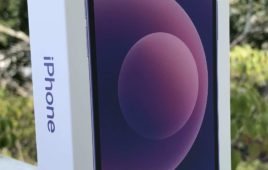T-Mobile Gets First Shot at Samsung 8-Megapixel Phone
By Monica Alleven
Wait a minute. Is that a phone or a digital camera? Company representatives say the Samsung Memoir 8-megapixel cameraphone was designed to look and feel like a customer’s point-and-shoot digital camera.
 |
The phone is coming to the United States exclusively through T-Mobile USA. Reports about the phone circulated for months, with some expecting the phone to land with AT&T.
The Memoir’s 8-megapixel camera comes with Xenon flash, 16x digital zoom and five shooting modes.
Integrated with the phone is Samsung’s new photo widget, which also allows customers to post images taken with the Memoir directly to an online photo sharing source, such as flickr, Kodak Gallery, Photobucket and Snapfish.
“This is the camera phone that will make people want to leave their digital camera at home,” said Bill Ogle, chief marketing officer for Samsung Mobile, in a press release. “When you combine the Memoir’s imaging capabilities, customizable menus and music player, not only is it a great phone, but the entertainment possibilities are unlimited.”
The Memoir sports a full-touch virtual QWERTY keypad and multiple messaging capabilities. It includes a music and video player and built-in Assisted GPS (A-GPS) navigation, which allows customers to use location-based services.
The companies did not give specific pricing information or a launch date, but the Memoir is expected to hit the market later this month.
Buzz Builds Around Toshiba Smartphone
By Andrew Berg
There’s big buzz surrounding the expected unveiling of a Toshiba smartphone at Mobile World Congress in Barcelona. The Web has been flooded with video and photo reviews, like this from Engadget, of Toshiba’s TG01 smartphone, which uses Qualcomm’s Snapdragon architecture.
Analysts are saying the phone could be a serious competitor for the iPhone and HTC Touch.
The Toshiba TG01 is the mobile industry’s first Qualcomm Snapdragon device. The handset is only 9.9 mm thick, but boasts a 4.1-inch WVGA touchscreen, GPS, Wi-Fi, HSDPA, a microSD slot, and an overlay on the Windows Mobile 6.1 operating system that gives it a unique-looking user interface. Preliminary reviews have been positive.
Nearly every smartphone device is measured against the reigning iPhone 3G. While the TG01 boasts faster processing speeds and a thinner shell than the iPhone, Apple’s seamless UI seems to be the feature to beat.
Smartphones are one of the few sectors of the wireless market that have enjoyed relatively strong sales amid a deteriorating macroeconomic environment. AT&T recently reported 1.9 million iPhone 3G activations in the fourth quarter.
DTV Transition Gets Delayed
By Monica Alleven
The acting chairman of the FCC welcomed yesterday’s news that the U.S. House of Representatives voted to postpone the shutdown of analog TV signals to June 12, but it wasn’t good news for Qualcomm.
“It has long been clear to me – and it’s even clearer since I became acting FCC chairman two weeks ago – that the country is not prepared to undertake a nationwide transition in twelve days without unacceptably high consumer dislocation,” stated Michael Copps, acting FCC chairman.
The additional four months allows more time for a more phased transition, including a consumer-friendly converter box coupon program, stepped-up consumer outreach and dealing with coverage, antenna and reception issues, he said.
Qualcomm, which uses vacated TV spectrum for mobile TV services, had asked that any legislation retain the Feb. 17 switchover date for nine TV stations in four markets – Boston, Houston, Miami and San Francisco. It was unknown at press time whether Qualcomm received any provisions in the measure, which now goes to President Barack Obama for his signature.
“We are disappointed with the passage of legislation extending the DTV transition date to June 12th,” Qualcomm said in a statement. “… We are encouraged that several Congressmen and senators who supported the delay stated that this would be a one-time delay only. In light of the fact that the legislation, as amended and finally passed by Congress, allows TV stations to transition voluntarily between now and June 12th, we cannot determine the specific impact of the final bill’s passage on our MediaFLO business.”
Sprint Nextel Gets More Time in Affiliate Fight
By The Associated Press
KANSAS CITY, Mo. (AP) — An Illinois judge has given Sprint Nextel Corp. until January to cease operating part of its Nextel phone network across a swath of the Midwest.
Sprint affiliate iPCS said Wednesday that the Cook County Circuit Court filed a final order in the company’s lawsuit against Sprint. The order gives Sprint Nextel until Jan. 25, 2010, “to cease owning, operating and managing” the Nextel network in iPCS Wireless’ service area.
A judge earlier ruled Sprint’s 2005 acquisition of Nextel Communications violated an exclusivity agreement with iPCS.
iPCS’ territory covers parts of Michigan, Indiana, Illinois, Iowa and Nebraska.
A Sprint spokesman said the company was implementing a plan to address the court’s ruling but wouldn’t provide details.
Cisco Earnings Down; January Notably Weak
By Peter Svensson, AP Technology Writer
NEW YORK (AP) — Technology bellwether Cisco Systems said Wednesday that incoming orders declined dramatically in January, indicating that the shrinking economy has more pain in store for the industry.
Chief executive John Chambers said the company, the world’s largest maker of computer networking gear, saw fewer and fewer orders as its latest quarter progressed. In November, orders were down 9 percent from the year before. In January, the drop was 20 percent.
“That was a bit of a shock,” said analyst Erik Suppiger at Signal Hill Capital Group.
Cisco’s fiscal second quarter ended Jan. 24, nearly a month after other technology companies that have reported their quarterly results recently. That means Cisco’s results provide a window into future reports from the rest of the industry. Cisco is also sensitive to trends in the market because more than 80 percent of its revenue is from sales, rather than recurring service contracts.
Chambers projected a 15 percent to 20 percent drop in revenue in the current quarter. That would put revenue at $7.8 billion to $8.3 billion, below the average estimate of $8.7 billion projected by analysts polled by Thomson Reuters.
Shares in San Jose, Calif.-based Cisco fell 71 cents, or 4.5 percent, to $15.13 in extended trading after Chamber’s comments.
The decline in orders was spread across the globe, though Europe and Japan had a better appetite than the U.S. and emerging markets.
Switches and routers, Cisco’s core products, saw the biggest declines. Revenue grew from services and some new, still minor businesses like videoconferencing.
As expected, the public sector was a bright spot, with orders up around 5 percent. Telecommunications service providers, meanwhile, cut their orders by about 20 percent.
For the just-ended quarter, sales were $9.1 billion, down 7.5 percent from a year ago. The company announced at the start of the quarter that it would cut back on discretionary expenses and freeze hiring. But it wasn’t able to slash expenses as quickly as sales fell and its profit dropped 27 percent to $1.5 billion, or 26 cents per share, from $2.1 billion, or 33 cents per share, a year ago.
Excluding items, earnings were 32 cents per share, beating the average analyst estimate by 2 cents.
Cisco’s goal is to save $1 billion in costs during the fiscal year, and executives said it was well on its way to achieving that.
Unlike many other technology companies, it hasn’t yet announced big layoffs, and Chambers said it still hoped to avoid any.
But if business continues to deteriorate dramatically and layoffs become necessary, the cuts will likely involve at least 10 percent of Cisco’s work force of 67,300, Chambers said.
“It needs to be a critical mass to justify the loss of business momentum, impact on employees and impact on key projects,” the CEO said. “If we execute successfully … we may be able to avoid broad downsizing events.”
Cisco itself is well set to weather tough credit markets, ending the quarter with $29.5 billion in cash and equivalents. Executives repeated their intention to grab market share from weaker competitors in the downturn, as the company has done in previous economic troughs.
Explay to Unveil Mobile-Projection Module at MWC
By Andrew Berg
Explay announced that it will unveil the Colibri mobile-projection module with SPEckle-free LCoS laser technology (SPELL) at the 2009 Mobile World Congress in Barcelona.
At less than five cubic centimeters in volume, Colibri, Explay’s third-generation projection module, can project multimedia content onto any curved or flat surface.
Embedding the module will turn a cell phone into a mobile media projector.
“The market for cellular projection is currently composed of companion handheld projectors and embedded projectors. Explay’s technology can serve both markets and can be customized according to the needs of each customer,” said Daniel Oleiski, CEO of Explay.
The idea for cell phones with embedded projectors is relatively new. Logic Wireless recently released the world’s first fully functional projector phone, the Logic Bolt, at CES. The technology has yet to be perfected, with a consumer-palatable size and price the main sticking points.
Nokia Siemens Intros New Flexi
By Monica Alleven
Nokia Siemens Networks (NSN) announced the launch of the Flexi Multiradio Base Station, which covers GSM/EDGE, W-CDMA/HSPA and LTE in a single unit.
The Flexi architecture was a game changer when it came out a couple years ago, moving from the big refrigerator-style products to one that is more compact and better for the environment, explained Dhruv Khanna, head of NSN’s radio access business for North America. The multiradio product takes that innovation one notch higher, he said, and consumes about the same amount of power as a household appliance, like a TV.
Running multiple technologies in a single base station means reduced operating expenses for operators due to fewer site visits and reduced maintenance.
The hope is to begin deployment of the multiradio base stations in 2010, he said. NSN also offers a Flexi base station for WiMAX.
Report: iPhone Users More Aware of Ads
By Wireless Week Staff
Here’s more evidence that iPhone users are more likely to use the mobile Web. Limbo and GfK Technology released their latest joint Mobile Advertising Report, and, you guessed it, iPhone users are more than twice as likely as non-iPhone users to browse the mobile Web and three times more likely to use a location-based service (LBS) or location-based social network.
Limbo, which bills itself as one of the largest mobile social networks in the United States, said this marked the first time the report compared iPhone users with non-iPhone users to better evaluate the impact of mobile marketing on each platform.
In a press release, Limbo CEO Jonathon Linner said they found that iPhone users are not only more accessible, but also more aware of all mobile ads, including those outside the typical SMS and mobile Web formats.
While 33 percent of mobile consumers recalled seeing mobile advertisements in the quarter, 41 percent of iPhone users recalled seeing mobile ads. The majority of the ads were seen in SMS text messages, twice as much as mobile Web ads, which are the second most common type of mobile ad viewed.
FirstNews Briefs for Feb. 5, 2009
Companies in the news: Handmark, FreeRange Communications, Cincinnati Bell, TracFone Wireless, Syniverse Techologies, RF Micro Devices, Mojiva, Motorola, WiMAX Forum, TeleCommunication Systems, Bluegrass Cellular, Flat Wireless, NTCH-Cleartalk-Colorado, Cricket Communications.
• Handmark, provider of the news and information service Pocket Express, is acquiring FreeRange Communications, a privately held mobile technology company in Portland, Ore., that offer a mobile publishing platform for media companies and content publishers to create their own branded applications. Financial terms were not disclosed.
• Cincinnati Bell’s wireless service revenue in the fourth quarter was $72 million, up $2 million from the year-ago quarter. Cincinnati Bell had 551,000 wireless customers at the end of the fourth quarter, which included year-over-year growth of 1 percent in its postpaid subscriber base. Postpaid quarterly ARPU was $48.46, an increase of $2.32 from the fourth quarter of 2007, reflecting the company’s focus on acquiring smartphone subscribers.
• Prepaid provider TracFone Wireless announced its launch of SafeLink Wireless in Massachusetts and Georgia. SafeLink will serve as the company’s distribution of Lifeline, a U.S. government-supported program ensures phone service is available and affordable for eligible low-income households. The SafeLink Wireless service will provide eligible low-income households a free cell phone, mobile access to emergency services and free 80 minutes of air time, monthly, for one year.
• Syniverse Technologies has launched its IP Packet eXchange Network Transport solution (IPX) to help global operators keep up with increasing data volumes while maintaining quality of service for subscribers. Syniverse also announced the launch of Syniverse RoamWise, a forecasting tool for GSM roaming.
• RF Micro Devices announced the availability of the RF2815 – a GPS LNA module with integrated filter designed for use in GPS receivers. The company says the highly integrated RF2815 is optimized for both solution size and performance and is especially suited for battery-powered mobile devices, such as portable navigation devices (PNDs) and GPS-enabled CDMA handsets.
• Mojiva says it has served more than 1 billion mobile ads in its first eight months of operation.
• Motorola says its public key infrastructure (PKI) Center of Excellence in San Diego has been selected by the WiMAX Forum to be a root certificate authority for WiMAX devices worldwide. Devices that will connect to a WiMAX network – such as cell phones, laptop computers and portable media players – are generally required to have a device certificate in order for that device to be authenticated and become functional on a network.
• TeleCommunication Systems (TCS) announced the company signed in 2008 multiple long-term agreements with wireless carriers throughout the United States for its E911 solutions. TCS now provides Hosted Mobile Positioning Center (MPC) and Hosted Position Determining Entity (HPDE) capabilities for E911 customers including regional wireless providers Bluegrass Cellular, Flat Wireless, NTCH-Cleartalk-Colorado and nationwide wireless provider Cricket Communications.




